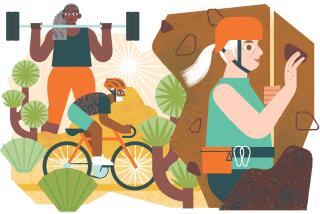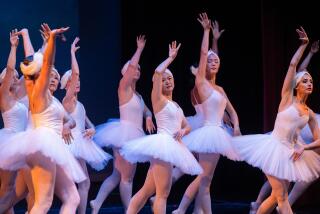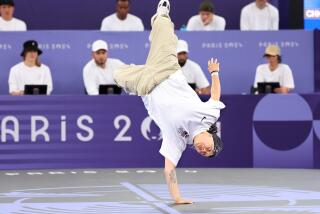Exercisers sweat as they twirl
- Share via
BALTIMORE — About two dozen women and men trooped into a neighborhood church on a recent afternoon to slough off winter pounds and become more in touch with their bodies.
They did not use complicated exercise machines or torturous-looking Pilates devices, but something far more friendly and familiar: the hula hoop.
“I hate the thought of going to the gym, but pick up a hoop and it can be playtime,” said Noelle Powers, 30, who is teaching the six-week course. “It’s a great way to burn calories and strengthen muscles, especially core muscles, and it can be very meditative.”
The hula hoop, the baby boomers’ beloved toy, is back. Hooping classes are popping up at gyms and community centers nationwide, including several in the Baltimore-Washington area. Hipsters tote hoops to concerts and dance clubs. And many celebrities are giving the hoop a whirl, including singer Beyonce, who reportedly uses it to maintain her famously “bootylicious” figure.
“People didn’t even imagine that you could do things like this with a hula hoop,” said Rayna McInturf, founder of Hoopnotica, a California-based hooping school.
Advanced dancers pull off elaborate tricks -- such as twirling a hoop on their feet while standing on their heads -- but most of the students in Powers’ first class were looking to nail down the basics and enjoy a fun workout.
As they picked out hoops to use, twins Jeannette Young-Wingfield and Jean Faulcon, 56, reminisced about growing up in the 1950s.
“All the little girls would get together and hula hoop,” Faulcon said. “I loved the ‘swish swish’ sound that it made.”
Hoops for adults are wider and heavier than those for kids, which makes them easier to spin around a larger waist. And fans usually just call them “hoops” -- since they aren’t a part of the traditional Hawaiian hula dance.
The hula hoop was introduced in 1958 by the Wham-O company of California, producers of other childhood delights such as the Slip-n-Slide and the Frisbee. More than 20 million hoops were sold in the first six months of production, according to Wham-O marketing associate Martin Marechal.
The hula hoop became an iconic toy of the day and is often noted, along with flagpole-sitting and goldfish-eating, as one of the great fads of the 20th century. Sales dropped in the early 1960s, Marechal said.
Hoops grew in popularity with adults after the Colorado-based jam band The String Cheese Incident started flinging them into the crowd at concerts in the 1990s. Hoop dancing became a popular event at underground dance parties and burlesque shows, and the demand for classes grew.
“There was an explosion [of interest] about four years ago,” McInturf said. “It went from me knowing everyone in L.A. who was a hoop dancer to hundreds and thousands of people around the world hoop-dancing.”
Several websites offer adult hoops and instructional DVDs for sale. San Francisco’s Christabel “Hoopgirl” Zamora said that she had sold more than 20,000 hoops and McInturf said that she saw her sales jump six-fold in 2006.
Hoop dancers have appeared in everything from music videos -- including Justin Timberlake’s “What Goes Around” and Beyonce’s “Work It Out” -- to Nevada’s edgy Burning Man festival. In November, about 20 people hooped on New York rooftops as part of a work of performance art, according to an article in the New Yorker magazine.
Powers, who learned to hoop while living in Seattle, has performed with the Fluid Movement water ballet and burlesque performers Trixie Little and the Evil Hate Monkey.
Powers makes her own hoops from plastic tubing and decorates them with colored tape, fabric or ribbon. She brought several dozen -- one sparkly purple, another red-and-white like a candy cane -- to St. John’s United Methodist Church, a space maintained by a partnership between congregation members and the Red Emma’s anarchist collective.
After students chose hoops, Powers led them through a series of stretches. She instructed them to hold the hoops behind their backs and bend forward. Then it was time to spin.
As Faulcon, a federal government employee who belly dances in her spare time, rocked from foot to foot, the hoop gyrated around her waist, appearing as imperturbable as one of Saturn’s rings.
Her sister’s hoop was not so well-behaved.
“I don’t remember it being like this,” said Young-Wingfield, a nurse, as her hoop clattered to the floor. Throughout the church, students bent down to pick up fallen hoops and try again.
“If it starts to slip, go faster,” Powers said. “Try hip, hip, hip, hip to get it back up there.”
Soon the room was filled with a soft breeze from the whirring hoops as students found the right rhythm. Then it was time to try more moves -- revolving the hoops around hands, arms and necks.
Katie Villegas, 37, folded her hands above her head like a belly dancer as she shook her hips. On the other side of the room, Regina Armenta, 33, a yoga instructor, spun a yellow-and-green striped hoop around her neck.
Corey Eberhart, 33, and Jackie Gill, 33, crashed into each other with their hoops and burst into giggles.
After the class, Gill, who works in real estate insurance, pushed a damp tendril of hair from her forehead.
“It’s a good workout,” she said. “And you just can’t help but feel happy when you’re in a hoop.”
More to Read
Sign up for The Wild
We’ll help you find the best places to hike, bike and run, as well as the perfect silent spots for meditation and yoga.
You may occasionally receive promotional content from the Los Angeles Times.






